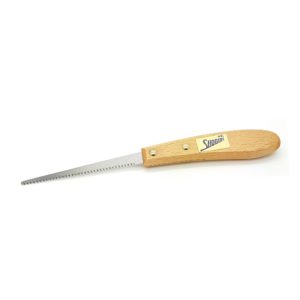Possibly the most versatile of the Japanese mini flush cut saws. There are teeth on both sides of the blade. It is important to note which way is up. With the blade face up, there is no set to the teeth, and therefore no risk of scratching the flush surface which comes into contact with the saw. You can cut to the left or to the right using either row of teeth.
Ideal for the flush trimming of wooden dowels or for cutting the protruding ends of through tenons. The highly flexible blade allows access into tight corners.
The other face of the blade has a tooth offset of 0.1mm. This allows the mini saw to be used in a more conventional way and still maintain a high accuracy level. Ideal for cutting tenons and the like.
A wooden handle provides a comfortable grip.
Shogun FLD120 Specification
| Overall Length | 240mm |
| Blade Length | 120mm |
| Blade Thickness (Plate) | 0.5mm |
| Blade Thickness (Kerf) | 0.6mm |
| Tooth Spacing | 1.15mm (22tpi) |
Why Use A Japanese Pull Saw?
Harder Steel – Stays Sharp Longer
Cuts On Pull Action – Higher Cutting Accuracy
Requires Less Effort – Thinner blade is Light Weight To Use
The most noticeable design feature of a Japanese saw is that the teeth are angled backwards towards the handle. When in use, the cutting action is on the pull-stroke hence Japanese saws are often referred to as pull saws. The saw is designed to cut as you draw it through the timber, totally the opposite to a traditional western saw. The benefit of the pull saw design, is that as much pressure as desired can be applied to the cut without fear of the blade buckling. This gentle method of sawing also ensures far more accuracy and a much thinner blade can be used which equals less resistance and a faster cut.
£13.20
Please share this Woodworking product:
Contact us for more info on Shogun FLD120 Japanese Double Edged Flush Cut Pull Saw 120mm Length Price includes UK mainland delivery on orders over £100 plus VAT. Use the livechat below or email us for more info.
Carriage for the UK Mainland is FREE on all tool orders over £100 plus VAT - typically arriving within a few days. NEXT DAY DELIVERY options are also available. Also great prices for European and Worldwide shipping on all tools.











